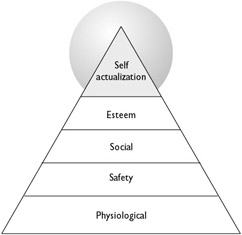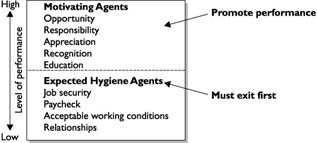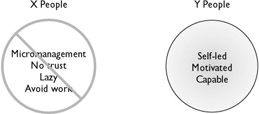Completing Organizational Planning
|
| < Day Day Up > |
|
Organizational planning calls upon the project manager to consider the requirements of the project and the stakeholders involved-and how the nature of the project will require the project manager and the project team to interact with the stakeholders. In addition, the project manager has to consider the project team itself and how the team will be managed, led, and motivated to complete the project work according to plan.
The goal of organizational planning is to identify and plan for the constraints and opportunities brought about by the nature of the project work, the team's competence, and the demands of the performing organization and stakeholders. There are scores of books written on organizational planning, theory, and project team motivation. The goal of this conversation is to know the essentials to pass the PMP exam.
Relying on Templates
All projects are somewhat different, but some may resemble historical projects. The resemblance to historical projects allows the project manager to use proven plans as templates for current projects. Specifically, in light of organizational planning, the project manager can use the roles and responsibility matrixes and the reporting structure of historical projects as a model for the current project. As a heuristic, current projects should emulate successful historical projects.
Applying Human Resource Practices
The performing organization will likely have policies and procedures for the project manager to follow. The HR department should specify:
-
Job responsibilities
-
Reporting structures
-
The project manager's role and autonomy
-
Policies regarding project team member discipline
-
The definition for customized organizational terms such as coach, mentor, or champion
Relating to Organizational Theories
There are many different organizational theories that a project manager can rely on to identify weakness and strengths, guide the project team, and move the project forward. The entire context of these theories is beyond the scope of this book; however, you should be familiar with several of these theories to pass the PMP exam.
Maslow's Hierarchy of Needs
According to Maslow, people work to take care of a hierarchy of needs. The pinnacle of their needs is self-actualization. People want to contribute, prove their work, and use their skills and ability. Figure 9-1 shows the pyramid of needs that all people try to ascend by fulfilling each layer one at a time.

Figure 9-1: Maslow says people work for self-actualization.
Maslow's five layers of needs, from the bottom-up, are
-
Physiological The necessities to live: air, water, food, clothing, and shelter.
-
Safety People need safety and security; this can include stability in life, work, and culture.
-
Social People are social creatures and need love, approval, and friends.
-
Esteem People strive for the respect, appreciation, and approval of others.
-
Self-actualization At the pinnacle of needs, people seek personal growth, knowledge, and fulfillment.
Herzberg's Theory of Motivation
According to Frederick Herzberg, a psychologist and authority on the motivation of work, there are two catalysts for success with people:
-
Hygiene agents These elements are the expectations all workers have: job security, a paycheck, clean and safe working conditions, a sense of belonging, civil working relationships, and other basic attributes associated with employment.
-
Motivating agents These are the elements that motivate people to excel. They include responsibility, appreciation of work, recognition, the chance to excel, education, and other opportunities associated with work other than just financial rewards.
This theory says the presence of hygiene factors will not motivate people to perform, as these are expected attributes. However, the absence of these elements will demotivate performance. For people to excel, the presence of motivating factors must exist. Figure 9-2 illustrates Herzberg's Theory of Motivation.

Figure 9-2: The absence of hygiene factors causes a worker's performance to suffer.
McGregor's Theory of X and Y
McGregor's Theory states that management believes there are two types of workers, good and bad, as seen in Figure 9-3.

Figure 9-3: Management believes 'X' people are bad and 'Y' people are good.
-
X is bad. These people need to be watched all the time, micromanaged, and distrusted. X people avoid work, responsibility, and have no ability to achieve.
-
Y is good. These people are self-led, motivated, and can accomplish new tasks proactively.
Ouchi's Theory Z
William Ouchi's Theory Z is based on the participative management style of the Japanese. This theory states that workers are motivated by a sense of commitment, opportunity, and advancement. Workers in an organization subscribing to Theory Z learn the business by moving up through the ranks of the company.
Ouchi's Theory Z also credits the idea of 'lifetime employment.' Workers will stay with one company until they retire because they are dedicated to the company that is in turn dedicated to them.
Exam Watch
If you need a way to keep McGregor's X and Y and Ouchi's Z all separate in your mind, think of this: X is bad; Y is good; and Z is better.
Expectancy Theory
Expectancy Theory states that people will behave based on what they expect as a result of their behavior. In other words, people will work in relation to the expected reward of the work. If the attractiveness of the reward is desirable to the worker, they will work to receive the reward. In other words, people expect to be rewarded for their effort.
Completing Stakeholder Analysis
The project manager must make all efforts to identify all of the project stakeholders. Stakeholder analysis is the process of:
-
Identifying the project stakeholders
-
Identifying and documenting stakeholders' needs and concerns for the project
-
Identifying stakeholders' ability to contribute to the project
-
Prioritizing stakeholder demands for project completion
-
Creating a communications methodology to gather and disperse information to the appropriate stakeholders when needed. (More on this in Chapter 10.)
|
| < Day Day Up > |
|
EAN: 2147483647
Pages: 209
- An Emerging Strategy for E-Business IT Governance
- Linking the IT Balanced Scorecard to the Business Objectives at a Major Canadian Financial Group
- Technical Issues Related to IT Governance Tactics: Product Metrics, Measurements and Process Control
- Managing IT Functions
- Governing Information Technology Through COBIT